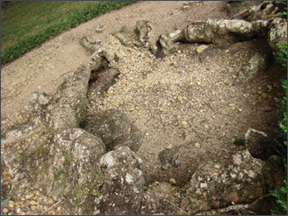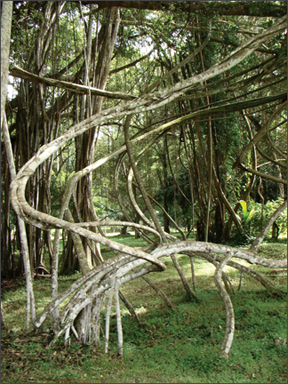Extended mission
Sri Lanka’s oldest Botanical Garden:
By Sajitha Prematunge
[email protected]
I was expecting a well pruned garden. In stead I walked in to a
pathway on either side of which were thick undergrowth. It is the oldest
Botanical Gardens in Sri Lanka. Ring a bell?
|

Say cheese. How do I look? |
|

Who said that the garden is only for lovers, Ah? |
|

The tap roots of Sri Lanka’s oldest rubber tree jut out from the
soil |
|

The perfect getaway |
That’s it, it’s Botanical Gardens Gampaha (BGG). Although it is
renowned as a hot spot for courting, there is much more to see at BGG,
including rare flora including endemic plant and numerous plants with
medicinal value.
The Garden is situated near the town of Asgiriya, about 1 km from the
city of Gampaha. It can be reached either by bus or by train from Kandy,
Ja-Ela or Minuwangoda.
Although we missed the seven a.m. train from Fort rail way station,
we were able to reach the garden within two hours. Just a short walk
from the Gampaha-Minuwangoda main road the Botanical Gardens of Gampaha
opens up to a host of rare plant species in its natural and welcoming
surrounding.
Since it is situated in the wet zone a typical wet zone climate
prevails. The Southwest monsoon is the main source of precipitation, but
the garden to some extent also depends on conventional rains. Annual
mean rainfall is approximately 2500 mm, while mean temperature is about
28 C.
The garden spreading across a total land area of approximately 37
acres, houses a total number of 400 species and 50 plant families, of
which approximately 18 are endemic. Its major collections include
arboretum, hibiscus collection, fernery, palmatum, fruit collection,
student’s Garden and tropical Forests.
I repeatedly found myself staring up at the canopy - abundant in this
garden - in spite of the fear of tripping over something. Travelling
from a concrete jungle like Colombo, the cool wetness of hundreds of
feet tall trees is a welcoming sensation, barely allowing me to close my
eyes because I wanted to drink it all in before it was time for me to go
back.
Founded in 1876 to introduce Para Rubber to Sri Lanka by the British
rulers, the garden was later developed as a standard Botanical Garden by
adding and developing new plants and sections.
Many of the rubber trees of the 19th century are still available in
the Garden, although I was in for a disappointment when I was taken to
Sri Lankas oldest rubber tree in the vicinity. Only the roots of the
tree were spared by a rainstorm back in 1987. This was one of the
original rubber seedlings that were shipped in from the Royal Botanical
Gardens (RBG), Kew.
|

Nature, the best artist |
They were introduced to RBG from regions deep in the Amazon,
transported across the Atlantic by the cargo ship S. S Amazonas in the
1960s. The tree has once yielded a record breaking 392 ib of crude
rubber within four years and five months. The diameter of the tree is
about 5.7 m. Another mammoth rubber tree in Section D of the park has a
diameter of 5.7 m and is 41 m in height.
British scientists found rubber that failed in India - due to
climatic reasons - thrived in Ceylon. Ceylon being dubbed as the ‘cradle
of the Asian rubber industry’ is never more apt when considering the
part it played as a nursery for rubber, distributing rubber seedlings to
many Asian countries in later years. Moreover BGG had for many years
operated as a rubber research station.
It now serves as a tropical low country Botanical Garden and is
engaged in conducting training programs in floriculture and landscaping,
exchanging knowledge and technology with foreign countries, providing
plant material for plant growers and maintenance of the herbarium.
The main objectives are providing facilities to students and general
public to observe and study the flora of Sri Lanka; ex-situ conservation
of local flora (conservation of living plants); maintenance of a
herbarium of local flora; dissemination of information of botany,
bio-diversity, floriculture and landscaping to almost any interested
person.
Tropical forests, flower garden, Japanese garden, palmatum, fernery,
students garden, and fruit garden are among its main attractions.
Finally we reached the palm lined path again as I turn back and try to
etch it in my memory.
My friend took a photograph of the path as an in-house dog
inadvertently stepped into pose for the photograph in the middle of the
palm lined path. For those in Colombo who can spare only a few hours of
travel time, the Botanical Gardens of Gampaha is the ideal getaway. |
